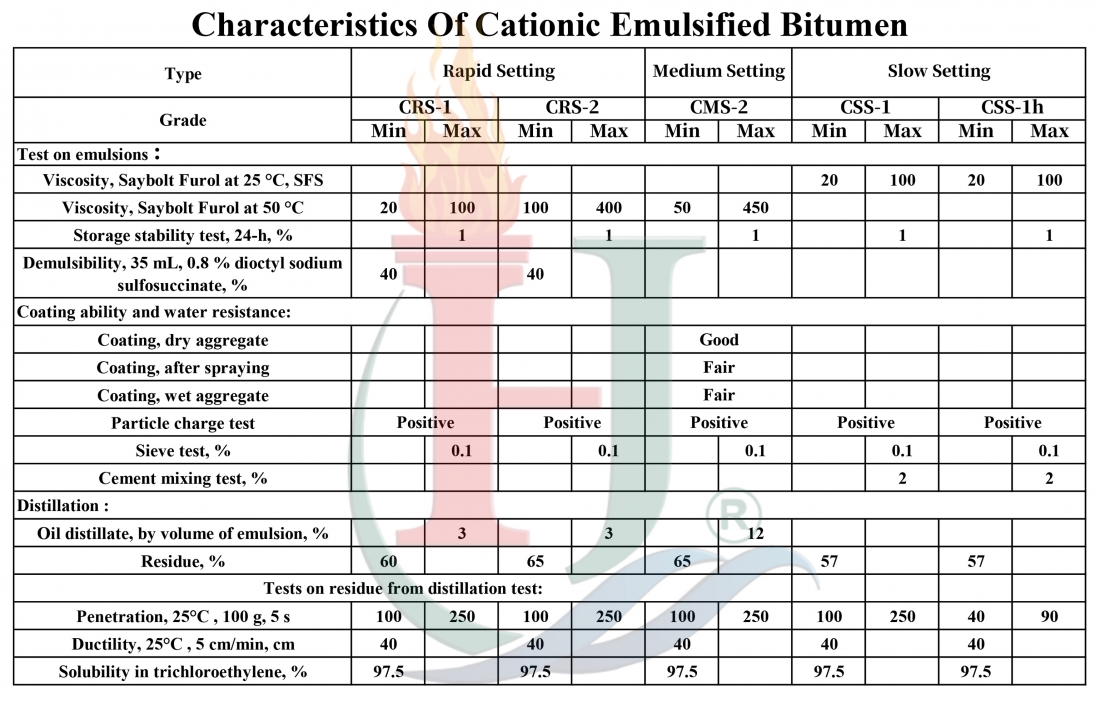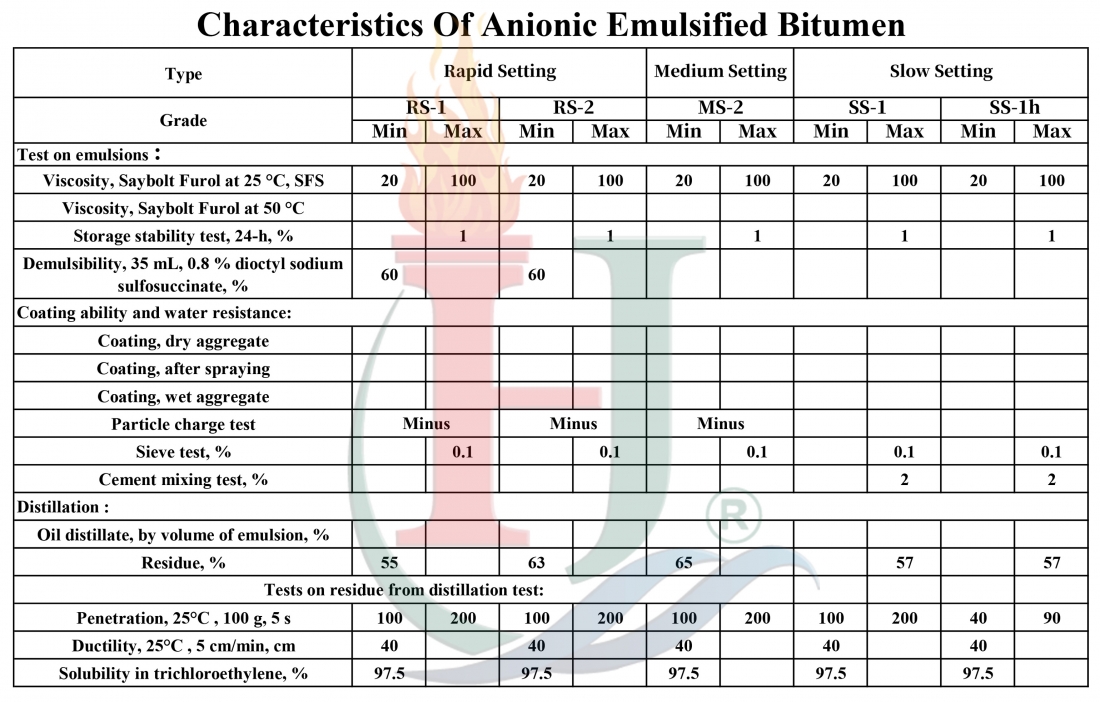Definition Of Bitumen Emulsion
Bitumen Emulsion is an area where technological progress is still being made to meet the requirements of pavement engineering. Anionic emulsions were first developed. They are currently less favored than the cationic emulsions, as cationic emulsions coat the aggregates more efficiently due to their positive load and have therefore better adhesion properties. Cationic Emulsion is both more favored and more widely used.
Emulsified Bitumen usually consists of bitumen droplets suspended in water. This dispersion under normal circumstances would not take place since everyone knows that oil and water don’t mix, but if an emulsifying agent is added to the water the asphalt will remain dispersed. Most emulsions are used for surface treatments. Emulsions enable much lower application temperatures to be used. Application temperatures range from 45°C to 70°C. This is much lower than the 150 to 190°C used for hot mix asphalt cement. The lower application temperatures will not damage the asphalt and are much safer for field personnel.
In the production of emulsion bitumen , water is treated with an emulsifying agent and other chemicals and is pumped to a colloid mill along with bitumen. The colloid mill breaks the bitumen up into tiny droplets. The emulsifying agent migrates to the asphalt-water interface and keeps the droplets from coalescing. The emulsion is then pumped to a storage tank.
Emulsion Bitumen is complicated and good chemistry is required to reach target desired emulsion properties. Variables in emulsion production include the base bitumen and the type and amount of emulsifying agent. There are two basic classifications of emulsions globally usually used, anionic bitumen emulsions and cationic bitumen emulsions. The type (chemistry) of the emulsifying agent used, determines the designation. Emulsifying agents are the chemicals used to stabilize the emulsion and keep the “billions and billions” of bitumen drops separated from one another. These compounds are large organic molecules that have two distinct parts to them. These parts are called the “head” and “tail.” The “head” portion consists of a group of atoms that chemically have positive and negative charge areas. These two charged areas give rise to the head being called polar (as in poles of a magnet). Because of this polarity, and the nature of some of the atoms in this polar head, the head is soluble in water. The tail consists of a long chain organic group that is not soluble in water but is soluble in other organic materials like oils (bitumen). Thus, an emulsifying agent is one molecule with both water-soluble and oil-soluble portions. This unique characteristic gives the chemical its emulsifying ability.
Emulsion Bitumen Usage in Prime and Tack Coat
TACK COAT:
What is tack coat?
Tack coat (also known as the bond coat) is a light application of asphalt emulsion between hot mix asphalt layers designed to create a strong adhesive bond without slippage. Heavier applications may be used under porous layers or around patches where it also functions as a seal coat.
Applying one layer of bitumen emulsion between surface below the road and the road surface which results to stick two layers and avoids slipping on each other. Cationic Rapid Set (CRS) or Cationic Slow Set (CSS) type of bitumen emulsion are used for this application.
Why use tack coat?
Without tack coat, the asphalt layers in a roadway may separate which reduces the structural integrity of the road and may also allow water to penetrate the structure
What type of emulsion should be used for tack coats?
The type of emulsion used for tack coats varies from country to country. Normal practice in the USA is to use a slow-setting emulsion that is diluted with water before application. In many European countries cationic rapid setting or specially designated low viscosity medium setting emulsions are used, which are applied undiluted.
- Tack Coat applications and facts:
- This application is necessary to stick two asphalt layers together.
- Preventing the layers from slipping on each other.
- Only 500 to 800 grams of bitumen emulsion is needed to pave per square meter.
- By applying Tack Coat, two layers act as one result in terms of consistency and stability.
- It is cost efficient with respect to the other approaches.
PRIME COAT:
Why use prime coat?
Prime coats protect the integrity of the granular base during construction and help reduce dust. In the case of a base which is to be covered with a thin hot mix layer or a chip seal for a low volume roadway, priming ensures a good bond between the seal and the underlying surface which otherwise would have a tendency to delaminate.
Implementation of a layer of bitumen emulsion on the base which prepares the base for performing another asphalt layer on it. Cationic Slow Set (CSS) type of bitumen emulsion is used for this application.
Why use asphalt emulsion prime?
Compared to cut back asphalt primes, emulsion primes are environmentally friendlier.
What type of emulsion is most suitable for emulsion prime?
- Slow-setting grades of asphalt emulsions (diluted with water before application) are suitable. With dense granular bases, or stabilized bases the surface may need to be broken up by scarifying before application, to ensure good penetration.
- Prime coat applications and facts:
- It penetrates to the base layer. It acts like a glue to the material of the base and binds them to each other.
- It makes the base layer hard and tough. It also makes the base layer water proof and acts as a seal by filling the voids and cavities.
- It sticks base layer and asphalt layer implemented on it.
- Only 1.1 kg of bitumen emulsion is enough to apply per square meter whereas cutbacks must be paved 1.3 to 1.8 kg per square meter.
- If the road has water hole or is water saturated, surface, prime coat must not be applied until water is removed.
- It is better to pave a water layer on the base surface for better penetration of prime coat.
- After 48 hours, the first asphalt layer must be applied.
- The application has low cost.

ADVANTAGES OF EMULSION
With viscosities in the range 0.5–10 Poise at 60°C, asphalt emulsion is of considerably lower viscosity than asphalt itself (100–4,000 Poise), allowing it to be used at the lower temperature. Low-temperature techniques for construction and maintenance reduce emissions, reduce energy consumption, avoid oxidation of the asphalt, and are less hazardous than techniques using hot asphalt. They are also more economical and environmentally friendly than cold techniques using cutback asphalts. The environmental benefit of asphalt emulsion is particularly positive when used for in-place or on-site techniques which avoid the energy usage and emissions associated with heating, drying, and haulage of aggregate. The construction of a roadway with cold techniques has been calculated to consume approximately half the energy of one of similar bearing capacity made with hot-mix asphalt (HMA). An environmental impact analysis (EIA) technique called “eco-efficiency” has been applied to emulsion maintenance techniques (micro surfacing and chip seal) and it was concluded that the emulsion system had less environmental impact than a thin hot-mix overlay.
Emulsions are water-based and in many cases can be diluted further with water for applications such as dust control and priming. They are also compatible with hydraulic binders like cement and lime as well as water-based polymer dispersions like natural and synthetic latex.
When mixtures of cement, latex, and asphalt emulsion cure, a composite binder is produced with a structure that cannot be duplicated with hot asphalt and with significantly improved properties compared to pure asphalt.
Types of Bitumen Emulsions
Bitumen emulsions are available in many different forms, either cationic or anionic, with varying breaking or setting rates and binder types and contents.
The two most common basic emulsion types are designated by the letter ‘C’ for cationic emulsions, as in CRS (cationic rapid setting), and by the letter ‘A’ in anionic emulsions, as in A.S.S (anionic slow setting).
Cationic
When the emulsion is being produced the cations are adsorbed by asphaltum droplets, negatively ions remain in the water. The undeniably most complete field of use is represented by the rapid setting emulsions.
Anionic
Most often, fatty acid and resin acid alkaline salts are used. They are obtained by saponification of the liquid resin, called Tall-Oil. This substance is a residual, distilled substance, a by-product of the paper pulp industry from resinous wood treated using the “sulfate” process.
The Co2Na group is the hydrophilic polar part. When in a solution in the continuous aqueous phase, the soap molecules become ionized; the Na (or K) ions are the cations adsorbed by the water and the rest of the molecules are the anions adsorbed by the bitumen globules.
The characteristics of an emulsion are designated by the terms rapid (R), medium (M) and slow (S). The main grades for bitumen emulsions are classified as follows:
Slow setting emulsions are more stable than medium setting emulsions which, in turn, are more stable than rapid setting emulsions.

Cationic vs Anionic
The coating of the bitumen particles by the emulsifier gives them an electrostatic charge. Depending on the type of emulsifier, this can generally be either negative or positive. The interaction of the charged particles is the reason it is possible to make emulsions that do not rapidly revert to the separate phases.
Emulsions in which the bitumen droplets are negatively charged are called anionic emulsions. Emulsions in which the particles are positively charged are called cationic emulsions.
To ensure that an emulsion remains either anionic or cationic, its pH (that is the balance of acids and bases) is controlled so that typically an anionic emulsion has an alkaline pH of over 7 and a cationic emulsion has an acidic pH of below 7.
This fundamental property of both anionic and cationic emulsions requires that they never be mixed. Mixing of an anionic emulsion and a cationic emulsion allows the negatively charged anionic droplets and the positively charged cationic particles to come together through electrical attraction. Ultimately enough droplets will combine and the bitumen will separate out, becoming unusable and destroying the emulsion.
Bitumen Emulsion Applications
Emulsion Bitumens primarily used for tack coats for use in between hot mix asphalt layers and prime coats for thin hot mix surfacing layers or a chip seal pavements.
– It can be used in damp environment on wet aggregates
– Road repair work can be carried out in minimum time
– Provides better tack coat with better workable conditions
– It can be used in any season
– Since heating is not required it can’t pollute air
– Long storage stability in clean containers/Tanks
Advantages and Uses of Bitumen Emulsions are:
- used extensively in bituminous road construction. Other than this they are used for maintenance and repair work.
- Emulsions can be used in wet weather even if it is raining.
- it Is ecofriendly as it is water based.
- used in soil stabilization in desert areas.
- It doesn’t need extra heat while placing.
- There is no wastage in placing and laying of bitumen.
- They possess properties.
- Rapid setting type of emulsion are used in surface of roads.
- Medium setting type of emulsion are used in premixing of bitumen emulsion and coarse aggregate.
- Slow setting type of emulsion are used with fine aggregates as the surface area is large and requires time for uniform mixing.










